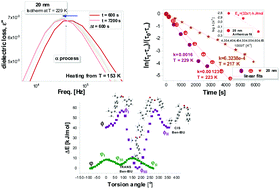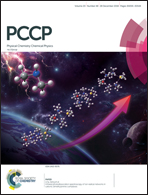Conformational changes underlying variation in the structural dynamics of materials confined at the nanometric scale†
Abstract
Broadband dielectric and Raman spectroscopies combined with calorimetric measurements and DFT calculations have been used to investigate the molecular dynamics of the benzyl derivative of ibuprofen (Ben-IBU) incorporated into aluminum oxide (AAO) templates of various pore diameters (d = 20 nm and d = 80 nm). Time-dependent experiments on the material confined in pores of d = 20 nm revealed the occurrence of a low activation barrier kinetic process, that was manifested as a variation in the integral intensities of some characteristic vibrations of carboxylic and benzene moieties as well as a shift of the structural relaxation process. Complementary DFT computations enabled us to identify its molecular nature as originating from cis to trans like conformational change. Our results clearly show that molecular rearrangements enforced by the interactions with the pore walls/substrate may affect the properties of the confined systems. Consequently, these effects must be taken into account to understand the dynamics and variation of the glass transition temperature in high (polymers) and low molecular weight glass formers subjected to spatial restrictions at the nanometer scale.

- This article is part of the themed collection: 2018 PCCP HOT Articles


 Please wait while we load your content...
Please wait while we load your content...